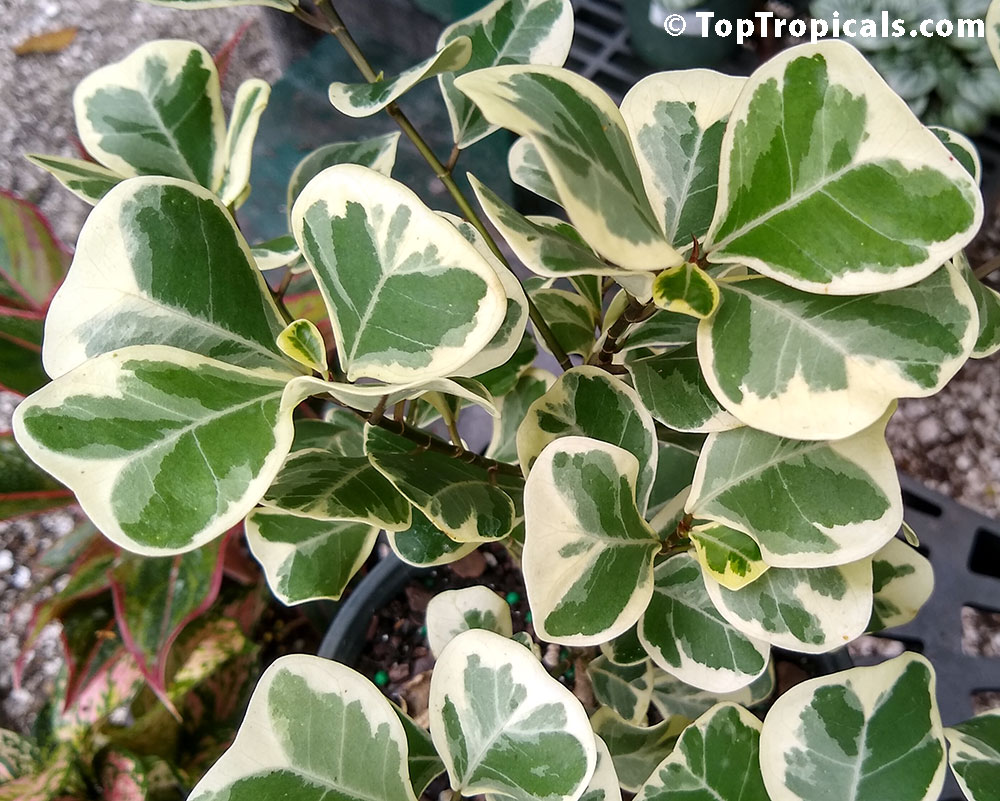Ficus natalensis (triangularis) variegata, Hearts in the Snow
6598 Ficus natalensis (triangularis) variegata, Hearts in the Snow






One of the coolest plants on the market! The Ficus Triangularis Variegata plant is one of the harder plants to find, even its non-variegated version is not common. This easy-care beauty shows off quantities of green and cream, triangle-heart-shape leaves that are held aloft on stiff compact stems. It's a super tough plant that can take a bit more abuse than other members of the ficus family. It is a slow grower eventually reaching 4 feet in height. The brighter the light, the better the variegation will be on new foliage.
This spectacular ficus can make an excellent houseplant. Decorate a table top with a single specimen or flank a doorway or entry with a pair of these easy-care ficus. They would also look terrific in a bright bedroom, bathroom, or kitchen.
This plant NEEDS light, if you do not give it enough light it may drop leaves or stop producing variegation. If grown indoors, use additional grow light for 10 hours a day. Water your plant whenever the soil feels dry to the touch. This handsome plant does not like wet feet so use your finger to make sure the soil is completely dry before offering moisture. Water thoroughly and then let the plant dry out again before it gets another drink.
Recommended Fertilizer: SUNSHINE Robusta - Rapid Growth Booster
Ficus natalensis (triangularis) variegata, Hearts in the Snow: Planting and Care Instructions
Plant Overview
Growth habit: This plant grows into a small to medium tree, about 10 to 20 feet tall when planted in the ground. It works well in gardens or yards with room to spread, but it can also be pruned to stay smaller and may be grown in a large pot with proper care.
Growing conditions: This plant can be grown outdoors in the suitable USDA zone. It is well-suited for small backyards, pots, or indoor spaces with enough light.
Watering: This plant does best with moderate to regular watering. Water it regularly, but let the top layer dry slightly between waterings.
Sun exposure: This plant grows well in both full sun and semi-shade. If kept indoors, give it as much light as possible for best growth.
USDA Zone: Zone 9-11. The USDA Plant Hardiness Zone Map categorizes North America into zones based on average annual minimum winter temperatures, each differing by 10 °F. This map serves as a basic guide for selecting appropriate plants for a region. However, it's not definitive; plant varieties vary in cold tolerance, and young plants typically need more protection. Additionally, local microclimates, like sheltered areas or sunny spots, can influence plant health and survivability beyond the general zone recommendation.
Hardiness: Protect from freezing. Plant hardiness indicates the coldest temperature a mature plant can endure briefly while staying healthy. This rating is a guideline and can vary among varieties of the same species. Young plants often need more cold protection. Additionally, a plant's survival can be enhanced by the microclimate of its location, which may provide shelter from wind or extra warmth, allowing it to thrive beyond its typical hardiness range.
Outdoor planting
Plant in well-draining soil and choose a location that matches the plant light and space needs. Improve poor soils by mixing in compost or organic matter. Dig a hole twice as wide and no deeper than the root ball - planting too deep can harm the plant. For better drainage, position the plant so the top of the root ball is slightly above ground level. Water thoroughly after planting. Outdoor plants may need temporary shade during the first weeks to protect them from strong sun or heat. Watch the soil moisture closely and water regularly until the plant is well established. Apply mulch around the base to help retain moisture and reduce weeds, forming a shallow basin to hold water. Keep mulch a few inches away from the trunk or stem to prevent rot.
Indoor planting
Use a container with drainage holes and a well-draining potting mix. Position the plant so that the top of the root ball is level with the surface of the soil - avoid planting too deep. A slow-release fertilizer can be mixed into the soil at planting time to support healthy growth. Place the plant in a location that matches its light needs, and water according to its care requirements. Be careful not to overwater, and ensure good airflow around the plant to reduce the risk of pests and disease.
Protecting Plants in Winter
When it gets cold, some plants need extra help. You can move potted plants indoors or under a covered patio. Young plants need extra protection because they are more sensitive to cold and less established. For plants in the ground, use frost cloth to keep them warm. Stop using fertilizer in late fall so plants can rest. Try to place plants in areas protected from cold wind, rain, and frost.
Cold Hardiness and Microclimates
USDA zone and hardiness are only general guidelines. Actual cold tolerance can vary based on plant variety and local conditions. Even small differences between varieties can matter. Also, warmer spots in your yard—like near a wall or fence—can help plants survive cold nights. These little warm areas are called microclimates, and they make a big difference.
